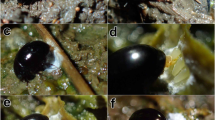Abstract
Larvae of the sciomyzid flyPherbellia cinerella are voracious predators of terrestrial helicid snails. Eggs are deposited in areas where snails occur and larvae hunt actively for their prey. Snail feces and mucus were tested to determine if they had any kairomone or stimulatory effects onP. cinerella. Adult flies oviposited more frequently on substrates containing fresh snail feces than on substrates containing snail mucus or water (control). However, mucus and feces both stimulated increased search behaviour in first instar larvae. These results are discussed in relation to snail biology, and the potential for augmentation of these flies in areas affected by pest snails.
Similar content being viewed by others
References
Baker, G.H. 1986. The biology and control of white snails (Mollusca: Helicidae), introduced pests in Australia.C.S.I.R.O. Technical Paper 25, 31 pp.
Berg, C.O. 1953. Sciomyzid larvae (Diptera) that feed on snails.J. Parasitol. 39:630–636.
Berg, C.O. 1966. The evolution of parasitoid relationships in malacophagous Diptera, especially the Sciomyzidae.Proceedings First International Congress on Parasitology pp. 606–607.
Berg, C.O., andKnutson, L. 1978. Biology and systematics of the Sciomyzidae. Annu. Rev. Entomol. 23:239–258.
Chock, Q.C., Davis, C.J., andChong, M. 1961.Sepedon macropus (Diptera: Sciomyzidae) introduced into Hawaii as a control of the liver fluke snail,Lymnaea ollula.J. Econ. Entomol. 54:1–4.
Cook, A. 1979. Homing by the slugLimax pseudoflavus.Anim. Behav. 27:545–556.
Cook, A. 1992. The function of trail following in the pulmonate slug,Limax pseudoflavus.Anim. Behav. 43:813–821.
Coupland, J.B., andBaker, G. 1995. The potential of several species of terrestrial sciomyzids (Diptera: Sciomyzidae) as biocontrol agents of pest helicid snails in Australia.Crop. Prot. 14:573–576.
Coupland, J.B., Espiau, A. andBaker, G. 1994. Seasonality, longevity, host choice and infection efficiency ofSalticella fasciata (Diptera: Sciomyzidae), a candidate for the biological control of pest helicid snails.Biol. Cont. 4:32–37.
Florkin, M., andLozet, F. 1949. Origine bactérienne de la cellulase du contenu intestinal de l'escargot.Arch. Int. Physiol. 57:201–207.
Knutson, L.V., Stephenson, J.W., andBerg, C.O. 1970. Biosystematic studies ofSalticella fasciata Meigen, a snail killing fly (Diptera: Sciomyzidae).Trans. R. Entomol. Soc. London 1223:81–100.
Lorvelec, O. 1990. La retour au gite chez l'escargotHelix aspersa. Etude au laboratoire.Biol. Behav. 15:107–116.
Maharaj, R., Appleton, C.C., andMiller, R.M. 1992. Snail predation by larvae ofSepedon scapularis Adams (Diptera: Sciomyzidae), a potential biocontrol agent of snail intermediate hosts of schistosomiasis in South Africa.Med. Vet. Entomol. 6:183–187.
Morris, D.E., andPivnick, K.A. 1991. Earthworm mucus stimulates oviposition in a predatory fly (Diptera: Anthomyiidae).J. Chem. Ecol. 17:2045–2052.
Nettles, W.C., andBurke, M.L. 1975. A substance ofHeliothis virescens larvae stimulating larviposition by females of the tachinid,Archytras marmoratus.J. Insect Physiol. 21:965–978.
Parle, J.N. 1963. Micro-organisms in the intestines of earthworms.J. Gen. Microbiol. 31:1–11.
Schwalb, H.H. 1961. Beiträge zur Biologieder einheimischen LampyridenLampyris noctiluca (Geoffr.) undPhausis splendidula (Lec.) und experimentelle Analyse ihres Beutefang-und Sexualverhaltens.Zool. Jahrb. Syst., Oekol. Geogr. 88:399–550.
Takabayashi, J., andTakahashi, S. 1989. Effects of host fecal pellet and synthetic kairomone on host-searching and post-oviposition behaviour ofApanteles kariyai, a parasitoid ofPseudaletia separata.Entomol. Exp. Appl. 52:221–227.
Wyatt, T.D., Phillips, A.D.G., andGregoire, J.C. 1993. Turbulence, trees and semiochemicals: wind-tunnel orientation of the predator,Rhizophagous grandis, to its bark beetle prey,Dendroctonus micans.Physiol. Entomol. 18:204–210.
Author information
Authors and Affiliations
Rights and permissions
About this article
Cite this article
Coupland, J.B. Influence of snail feces and mucus on oviposition and larval behavior ofPherbellia cinerella (Diptera: Sciomyzidae). J Chem Ecol 22, 183–189 (1996). https://doi.org/10.1007/BF02055091
Received:
Accepted:
Issue Date:
DOI: https://doi.org/10.1007/BF02055091




